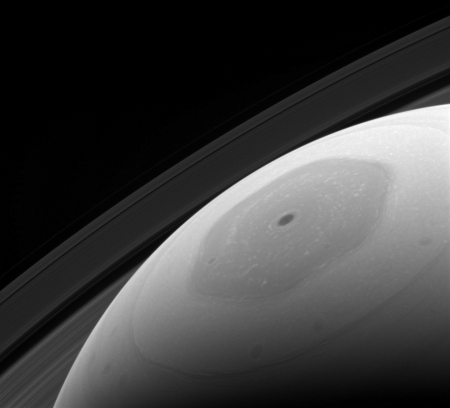Saturn’s north pole hexagon jet stream

Cool image time! The image on the right, reduced and cropped to show here, was taken by Cassini in January as it was preparing to head into its final 22 orbital dives between Saturn and its rings. The image shows the gas giant’s north polar, with all its magnificent features. As the press release notes, the north pole was in shadow for the first part of Cassini’s mission, and only in recent years has finally moved into sunlight so that the spaceship can see and image it.
Although the sunlight falling on the north pole of Saturn is enough to allow us to image and study the region, it does not provide much warmth. In addition to being low in the sky (just like summer at Earth’s poles), the sun is nearly ten times as distant from Saturn as from Earth. This results in the sunlight being only about 1 percent as intense as at our planet.
This view looks toward Saturn from about 31 degrees above the ring plane. The image was taken with the Cassini spacecraft wide-angle camera on Jan. 22, 2017 using a spectral filter which preferentially admits wavelengths of near-infrared light centered at 939 nanometers.
Be sure to look at the full image.

Cool image time! The image on the right, reduced and cropped to show here, was taken by Cassini in January as it was preparing to head into its final 22 orbital dives between Saturn and its rings. The image shows the gas giant’s north polar, with all its magnificent features. As the press release notes, the north pole was in shadow for the first part of Cassini’s mission, and only in recent years has finally moved into sunlight so that the spaceship can see and image it.
Although the sunlight falling on the north pole of Saturn is enough to allow us to image and study the region, it does not provide much warmth. In addition to being low in the sky (just like summer at Earth’s poles), the sun is nearly ten times as distant from Saturn as from Earth. This results in the sunlight being only about 1 percent as intense as at our planet.
This view looks toward Saturn from about 31 degrees above the ring plane. The image was taken with the Cassini spacecraft wide-angle camera on Jan. 22, 2017 using a spectral filter which preferentially admits wavelengths of near-infrared light centered at 939 nanometers.
Be sure to look at the full image.


